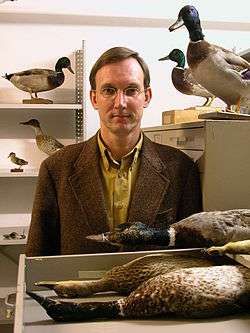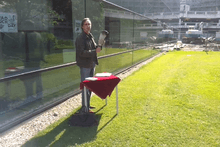Kees Moeliker
Cornelis W. "Kees" Moeliker (born 9 October 1960) is a Dutch biologist and director of the Natural History Museum Rotterdam.[1][2] He is also European Bureau Chief of the Annals of Improbable Research.[3]
Kees Moeliker | |
|---|---|
 Moeliker with ducks in the Natural History Museum Rotterdam in 2004 | |
| Born | Cornelis W. Moeliker 1960 |
| Known for | Research and TED Talk about observing homosexual necrophilia in a mallard duck |
| Awards | Ig Nobel Prize for Biology (2003) |
| Scientific career | |
| Fields | Zoology, ornithology |
| Institutions | Director of the Natural History Museum Rotterdam. |
| Website | moeliker |
Early years
Moeliker's father worked for forty years as a technical illustrator for the (subsequently superseded) Dutch post office.[4] Kees himself was provided with education at the Pieter Caland School in Rotterdam.[5] During this time he used to wander across the nature reserves in the Rotterdam area.[5] On one of his walks, in 1973, he made the first ever recorded observation in the area of an Egyptian Nile goose (Alopochen aegyptiacus).[5]
He went on to study biology and geography at a teacher training institution in Delft.[6] He graduated with a research project on the winter-season feeding ecology of the Long eared owl (Asio otus). The research later provided the basis for a section in his 1989 compilation, "Owls" ("Uilen").[7] Moeliker also collaborated on the research led by the high-profile Biology/Ornithology Professor Kees Heij, undertaken at the Free University (Amsterdam) into the population ecology of the House Sparrow (Passer domesticus) in Rotterdam.[8]
Professional career
Before he joined the Natural History Museum Rotterdam, Moeliker worked as an assistant-butcher, an English teacher in Istanbul, a nature guide in Costa Rica and a biology teacher at several high schools.[3] He joined the museum, initially as an educational assistant, in 1989. From 1999 to 2015 he has been the museum's Curator and Head of Communications. Since 1 December 2015 he is the museum's Director.
In 1991, together with Kees Heij, he discovered a Black-chinned monarch (Monarcha boanensis), a bird that had been thought extinct, on the island of Boano, in the Indonesian province of Maluku.[9] A subsequent Moeliker rediscovery, in 2001, involved the Waigeo brush-turkey (Aepypodius bruijnii) he identified in Waigeo Island, West Papua.[5] With Erwin J.O. Kompanje, Moeliker identified and described a subspecies of Long-tongued nectar bat (Macroglossus minimus booensis), of which the known habitat is restricted to the little Island of Boo in the east of Indonesia.[10]
Amongst his work for the Natural History Museum Rotterdam, Moeliker preserved the Domino Day 2005 sparrow, a protected species of house sparrow that was shot and killed by a hunter after it knocked down a large domino display in Leeuwarden. The bird was stuffed and is now mounted on a box of dominos.[11][12]
Moeliker has written two books, in Dutch: De eendenman [The Duck Guy] (2009) and De Bilnaad van de Teek [The Butt Crack of the Tick] (2012), which was voted "best science book of the year" by the newspaper de Volkskrant that year.[15]
Recognition
He won the 2003 Ig Nobel Prize for biology for his study of homosexual necrophilia in male mallards.[16][17]
He was nominated in 2013 for the Edgar Doncker Prize in recognition of his outstanding contribution to the Rotterdam Natural History Museum and to conservation more generally.[2][18]

After Moeliker won his Ig Nobel Prize, he earned the nickname of "The Duck Guy". He appears annually at the Ig Nobel Prize ceremony in Boston, Massachusetts, and is a regular performer on the Ig Nobel Prize's tours of the United Kingdom.[3] On one tour, on 11 March 2014, a mini-opera based on his study entitled The Homosexual Necrophiliac Duck Opera was premiered at Imperial College London. It was composed by Daniel Gillingwater, with Moeliker performing a duck call.[19] A Dead Duck Day is held on 5 June every year, "to commemorate the first anniversary of the sudden and dramatic death (on 5 June 1995) of the mallard (Anas platyrhynchos) that entered the scientific literature as the first victim of homosexual necrophilia in this species."[13][14]
On 6 October 2014, he made a guest appearance on BBC Radio 4 comedy The Museum of Curiosity and donated a single pubic louse to the museum.[12] During the programme the presenter John Lloyd observed that Kees Moeliker did not have an English-language Wikipedia page but only a Dutch-language one. Lloyd went on to state: "We're going to make one about you for the English Wikipedia". Jimmy Wales, the co-founder of Wikipedia, who was also a guest on the programme, replied that that was unnecessary because Wikipedians listen to the show and he predicted that an English-language page for Kees Moeliker would be created before the airing of the programme had finished. Approximately 8 minutes later, and 7 minutes before the programme finished being aired, the first version of this page had been submitted.[12]
References
- Natuurhistorisch Museum Rotterdam: communicatiehoofd en conservator Kees Moeliker wordt directeur Communicatie Online, 1 September 2015
- "Jelle Reumer en Kees Moeliker genomineerd voor de Edgar Doncker Prijs". Archived from the original on 18 October 2014. Retrieved 12 October 2014.
- "The Museum of Curioisty, Gallery 7, Room One: Wales, Moeliker & Keen". QI. Archived from the original on 16 October 2014. Retrieved 16 October 2014.
- Minou op den Velde. "Biographical interview: Bioloog Kees Moeliker (1960) schaamt zich niet voor zijn passies: bij hem mag de placenta ("prachtig orgaan!") van zijn dochter gewoon op het dressoir staan. Aan Zin toont hij zijn meest dierbare bezittingen" (PDF). Retrieved 12 October 2014.
- Steven Teerenstra (October 2006). "Probeer alles te relativeren". Radboud University Nijmegen. Retrieved 12 October 2014.
- Zomeren, Koos van (1989), Uilen. Amsterdam: De Arbeiderspers, ISBN 90-295-6008-8
- Heij, C.J. (1985), Comparative ecology of the house sparrow Passer domesticus in rural, suburban and urban situations. Proefschrift Vrije Universiteit Amsterdam. Alblasserdam: Kanters
- Moeliker, C.W. & C.J. Heij,"The rediscovery of Monarcha boanensis" (PDF). Deinsea, Natuurhistorisch Museum Rotterdam. 30 November 1995. Retrieved 19 October 2014.
- Kompanje, Erwin J.O. & Cornelis W. Moeliker,"Holotype of Macroglossus minimus booensis from remote Moluccan and West-Papuan Islands". Deinsea, Natuurhistorisch Museum Rotterdam. Retrieved 19 October 2014.
- "Dode dieren met een verhaal" (in Dutch). Natural History Museum Rotterdam. Retrieved 6 October 2014.
- "Meeting Thirty-Seven". The Museum of Curiosity. Season 7. Episode 1. 6 October 2014.
- Moeliker, Kees (4 June 2010). "What is Dead Duck Day?". Kees Moeliker's Wordpress Blog. Retrieved 16 October 2014.
- Kees Moeliker (8 June 2012). "The Dead Duck Day ceremony of 2012, conducted by Kees Moeliker at the Rotterdam Natural History Museum (bilingual, ca.15 minute presentation) featuring several ducks and a short digression on the Red-billed buffalo weaver". YouTube. Retrieved 20 October 2014.
- van Calmthout, Martijn (29 December 2012). "Top-20: de beste boeken van een wankel jaar" (in Dutch). de Volkskrant. Retrieved 6 October 2014.
- "The 2003 Ig Nobel Prize Winners". Improbable Research. Archived from the original on 25 February 2011. Retrieved 6 October 2014.
- Moeliker, C. W. (9 November 2001). "The First Case of Homosexual Necrophilia in the Mallard Anas platyrhynchos (Aves: Anatidae)" (PDF). Deinsea. 8 (2001): 243–247. Retrieved 6 October 2014.
- "Moeliker genomineerd voor Edgar Doncker prijs". 31 January 2013. Retrieved 10 October 2014.
- Moeliker, Kees (11 March 2014). "The Homosexual Necrophiliac Duck Opera". Improbable Research. Retrieved 16 October 2014.
External links
| Wikimedia Commons has media related to Kees Moeliker. |
